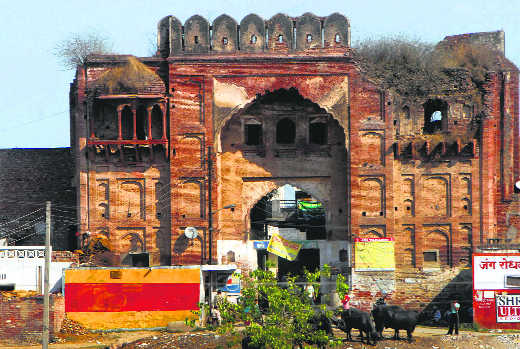Bhartesh Singh Thakur in Chandigarh
Two historical monuments in Haryana go missing. There are encroachments over archaeological sites. Heritage of thousands of years is waiting to be discovered even as history is in danger of getting erased. But thanks to suo motu contempt proceedings in 2012 by the Punjab and Haryana High Court against several Deputy Commissioners (DCs) of Haryana, some action has been taken. Seven years down the line, encroachments in Gurugram, Faridabad, Palwal and Karnal have been removed. Contempt cases against DCs of Hisar, Sirsa and Kaithal have been pending as hundreds of families continue to live at these sites of historical significance. “Had the Bench not been stringent, the DCs wouldn’t have got the encroachments removed,” says Puneeta Sethi, amicus curiae, in the cases against the DCs.
Curious case of missing minar
As many as 89 monuments in Haryana are under the Archaeological Survey of India. A CAG report, which was tabled on August 23, 2013, has made public that 92 monuments in the country have gone missing, including two in Haryana — Kos Minar at Shahabad (Kurukshetra) and Kos Minar at Mujesar (Faridabad). The Kos Minars were constructed by Afghan ruler Sher Shah Suri, and subsequently the Mughal emperors. “These minars were erected on the main highways across the Mughal empire to mark the distance of 3.2 km, which is one kos,” says Zulfeqar Ali, Superintending Archaeologist, Chandigarh Circle.
Regarding the Mujesar Kos Minar, the ASI was informed by the district authorities in January 1984 that the “land of Kos Minar no 13 had been allotted to a private company and the minar was demolished by the company”. No legal action had been taken against the company.
As per the CAG report, in 2004-05, the land of Kos Minar, Shahabad, was acquired by the Haryana Urban Development Authority and plots were sold to private parties. “At present, several buildings have been constructed there. There was no trace of the protected monument of national importance. The ASI had no information on when and how the monument disappeared,” said the CAG report.
The manpower and resources allocated are not enough to manage these huge sites, says Ali. In the conservation cadre in Chandigarh Circle, there are 19 sanctioned posts. Of these, seven are vacant. Then there are 71 sanctioned posts of field staff for ward and watch of the monuments. However, the size of the monuments is too enormous for this staff strength. There are 33 such historical monuments in Punjab also that need to be taken care of.
Enormity of encroachments
According to Zulfeqar Ali, six major historical sites in Haryana are under encroachments. These include Fort of Prithviraj Chauhan in Hansi, Harappan settlement site in Rakhigarhi, Hisar; Theh Polar at Siwan in Kaithal; Ther mound in Sirsa; ancient site Khokhrakot in Rohtak and ancient mound at Naurangabad in Bhiwani. These encroachment cases are pending in the court and the DCs have been facing contempt proceedings, he added.
Prithvi Raj Fort: As many as 163 families are living within the Prithvi Raj Fort in Hansi (Hisar) that need to be rehabilitated. Out of them, 122 families are landless. As many as 125 families have build up to two-room sets and 38 have three or more room-sets.
Rakhigarhi: The ancient site of Rakhikhas and Rakhishahpur are collectively known as Rakhigarhi. There are 89 encroachers at the Rakhikhas site and 69 on Rakhishahpur. It is the largest Harappan civilisation site but has been turned into a garbage dump yard and for baking cow dung cakes. A part of it is under cultivation. Besides, there has been plunder of antiquities by the local population.
For rehabilitation, the encroachers will be provided 100 sq yard plots. Those who own no land will have to pay Rs 200 per sq yard and those having some land will have to pay Rs 400 per sq yard. Families will be provided financial assistance too.
Theh Polar at Siwan, Kaithal: Antiquity of the site dates back to the Kushana period 2,000 years ago. The ruins situated on the south bank of the Saraswati river, about 4 km from Siwan village and 10 km from Kaithal, are said to mark the site of an ancient village destroyed during the Mahabharata period. During the excavations, the place yielded about 465 antiquities including coins, clay seals, weights, pottery, copper vessels and other minor objects. The encroachers have built nearly 500 houses. Dense habitation at the top of the mound and random digging for laying of sewerage tanks have disturbed the levels.
The Ther mound, Sirsa: It is about 5 km in circuit and 19.75 m high from the ground level. It lies in the south-east of the Sirsa town. The material remains of the ancient site are assignable to 3rd century. About 387 families, who were encroaching, had been removed so far. A ground survey of 671 houses on the top of the mound was carried out. In the next phase, 150 to 200 families would be rehabilitated.
The Naurangabad mound, Bhiwani: It has an area of 58.44 acres and a large number of Yaudehys, Indo-Greek, Kushana and Gupta coins have been found from this mound.
The Khokrakot mound, Rohtak: The mound has been mentioned in the Mahabharata. According to the ASI, it was possibly the capital of the Yaudheya Gana. A carved pillar capital found here shows winged lions with riders assignable to the Kushana period. A number of coin-moulds of the Yaudheyas, a terracotta plaque belonging to the Gupta period and coin of Samanta Deva, a 10th century ruler of Kabul, have been found so far. The town is said to have been rebuilt by Prithvi Raj Chauhan in the 12th century.
Unlock Exclusive Insights with The Tribune Premium
Take your experience further with Premium access.
Thought-provoking Opinions, Expert Analysis, In-depth Insights and other Member Only Benefits
Already a Member? Sign In Now










